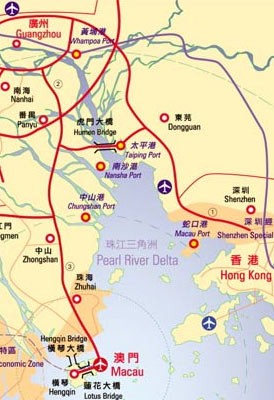Information
This guide is spread over several parts:
It is also available as a PDF, and is accompanied by a Thai language cheatshert.
No, we’re not in Thailand yet.
The first port of call is Macau, an ex-colonial Portuguese enclave, since reverted back to China. Think of it as Hong Kong’s much smaller Latin brother. The purpose of it in this trip is Macau airport, home for several low-cost airlines. One of which is Air Asia, who conveniently fly direct to Bangkok.
I spent no time in Macau other than at the airport. If you do stay here then you may be interested in its historical architecture and Casinos. Hopefully a future trip will provide a better insight into this region.
Transport

Macau is easily reached from Hong Kong, either by water, land, or air. Full details are to be found on the Macau Tourism website. Journey times range from 15 minutes to 40 minutes.
From China, the Kwee Kwan Motor Road Company runs a bus directly from Guangzhou (Garden Hotel) to Macau Airport, taking over 2 hours and costing 120 RMB. A ferry and TurboJet can be taken from Shenzhen.
If you do take the bus, make sure to keep your yellow sticker on display when going through Macau immigration. You must leave the bus and take all your belongings with you, and board the bus at the other side. The sticker is the only way the bus staff will recognize you amongst all the confusion.
Airport
Macau airport is very small, and barren of most things other than Duty Free shops. There is one restaurant, serving mostly inedible-looking food. There is nowhere to buy any other food, including snacks, apart from one or two drinks vending machines. If you are spending anytime here then bring your own food.
The airport hotel, across the road from the airport, does have a restaurant. This is split into two areas, one for Western food, and one for Chinese. Avoid the Western food, it is truly dire and not worth the high prices. The Chinese food looks a lot better, and is certainly more popular.
Air Asia
Air Asia is exactly like most other low-cost airlines: bright and cheerful, with no fuss and nothing free. The boarding-pass consists of a till receipt, and seats are not allocated. Expect a mad frenzy 10 minutes before boarding as mob-rule takes hold of the crowd.
The flights are quick and painless, and you are served by very attractive staff, speaking three languages (Thai, Chinese, and English, in the case of flights to Thailand). The planes were very clean, although some holes were noticed in the plastic wall fascia, through which an adventurous finger discovered the cavity between exterior and interior walls. Ouch.
Things to know
Currency
Macau currency is the Pataca, identified by a dollar sign or the code MOP. It is roughly of equivalent value to the Hong Kong dollar, and the Hong Kong dollar can be used interchangeably. Chinese RMB is generally accepted, although at an exchange rate determined by the receiver.
Visa
Automatic entry into Macau is granted to visitors from most countries, and ranges from 30 to 90 days. A full list can be found at the Macau Tourism website.
Be aware that Macau is a Special Administrative Region (SAR), and has a separate border and immigration control to China. If you are arriving from the mainland then you will need to leave China first, before going through Macau immigration. Typically this will take place at Zhuhai, just on the border between China and Macau. This gets very busy, and you can expect large queues and a lot of noise, chaos, and confusion. Make sure to stand in the correct line for foreigners, otherwise you will waste a lot of time. Be careful not to get caught in a stampede, should a new line open. The Chinese have no qualms about pushing.
Map courtesy of Ola Macau